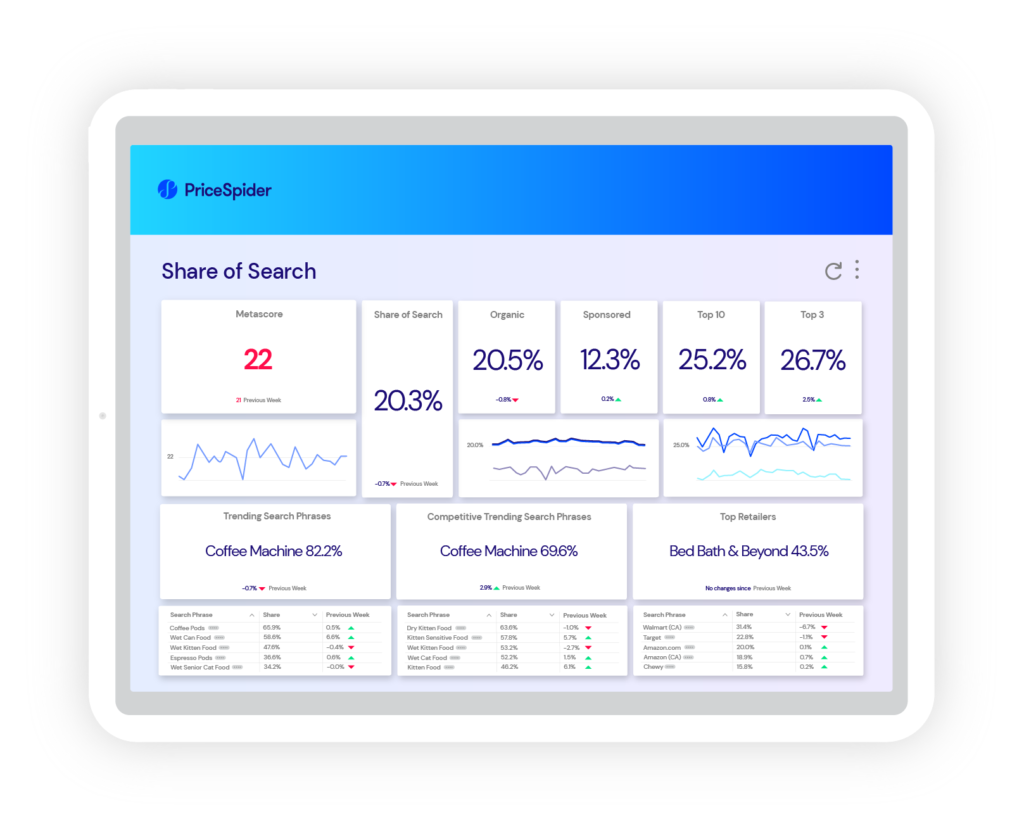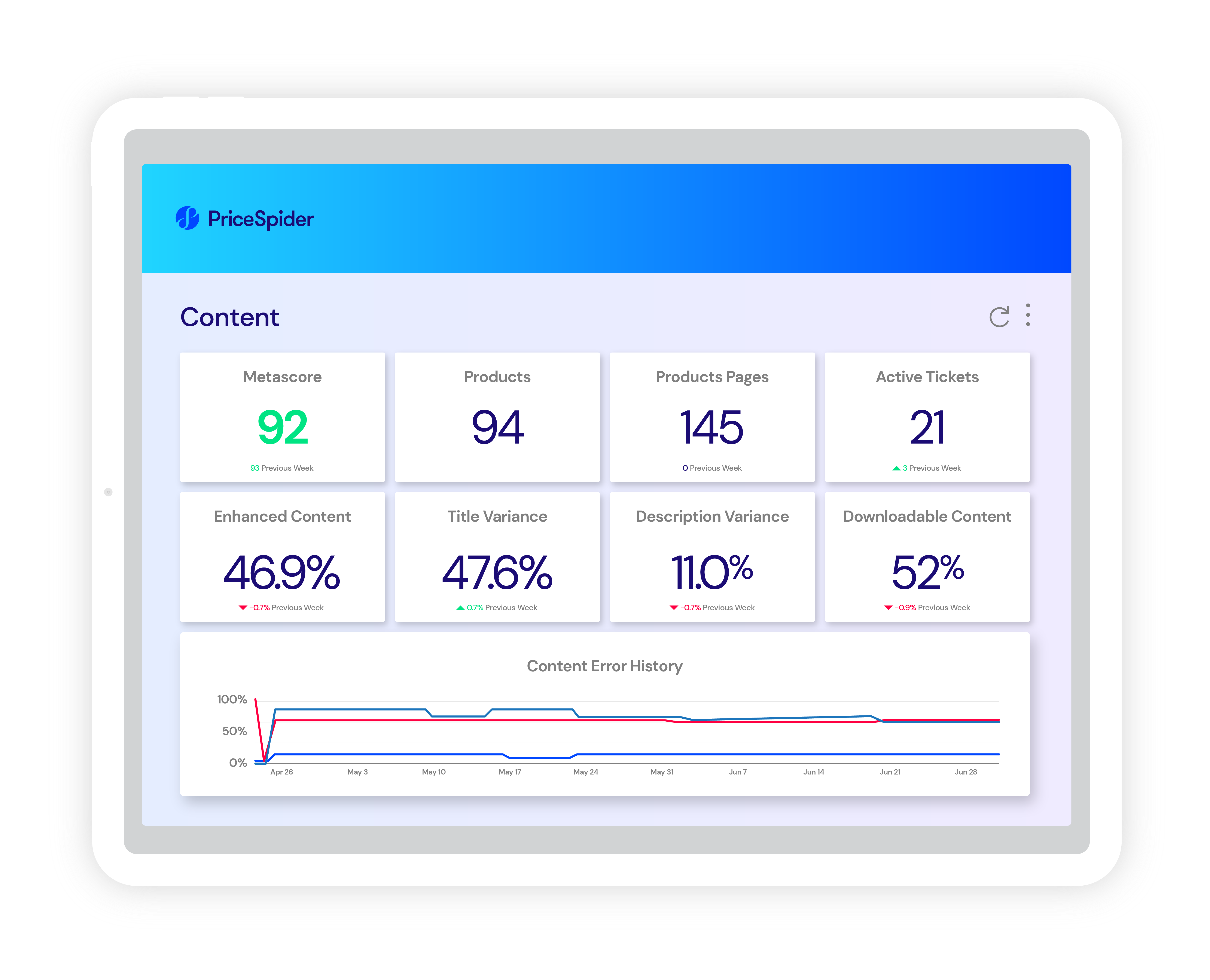Why are little kids unable to catch a baseball? They’re scared it’ll hit them. They flinch, take their eye off the ball, and whammy! They’re wearing it. That’s why father telling son to keep his eye on the ball is a tradition as old as time. Why is it, then, that we grow up, forget what our parents taught us, and allow ourselves to take our eye off the ball?
What if you were that kid and grew up to lead a brand’s ecommerce strategy? Surely, you would never take your eye off of what’s happening on the digital shelf. After all, the digital shelf is where consumers discover, research, compare, and buy products. It encompasses search engines, social media, online retailers and marketplaces, your brand’s website, industry blogs, and more.
Brands constantly compete to win the digital shelf, fight for the top spots in key search results, create more helpful content, and capitalize on opportunities to take a larger share of sales.
That makes digital shelf optimization critical to ecommerce success. And though you only have direct control over limited pieces of the digital shelf, it is imperative that you find a way to stay fixated on it so that you can ensure customers can see you. Without optimization, your target audience may not see you at all, and whammy — you’re out of the game.
In this guide, we explore:
- What digital shelf optimization means
- The benefits of digital shelf optimization
- How to optimize the digital shelf
For starters, let’s dig into what digital shelf optimization actually means.
What is digital shelf optimization?
Most ecommerce brands do digital shelf optimization on some level. But without a clear understanding of what it entails and why it matters, you’re going to miss some of the most significant opportunities to maintain and improve your position on the shelf.
The digital shelf is vast, but digital shelf optimization focuses on the components you control, namely, your product pages. Product pages play a central role on the digital shelf and serve several purposes throughout the customer journey.
When customers search for your product category, you want them to find you. When they land on your product pages, you want them to have everything they need to make an informed decision and feel confident your product is right for them. Ultimately, you want your product pages to outperform the competition.
Digital shelf optimization is the ongoing process of improving your product catalog’s digital performance. It includes solidifying your position in search results, increasing brand awareness, providing a better, more consistent customer experience, earning higher ratings and reviews, and winning more sales. It also involves using your ad spend efficiently, seizing timely opportunities (such as when a competitor is out of stock) and eliminating wasteful spending.
Primarily, digital shelf optimization is how you find the most successful product page content, then replicate that success across all of your distribution channels.
Benefits of digital shelf optimization
Digital shelf optimization brings a lot of direct benefits to your brand. By paying attention to the digital shelf and seizing the right opportunities, you can make your products more discoverable, ensure your brand creates the best impression, win more sales, and more.
Make your products more discoverable
For many consumers, if your products don’t show up on the first page of search results, they might as well not exist. Every retailer wants to display the best possible results for their customers. As a brand, your job is to ensure your products are the best results for the search terms people use to find products like yours. Digital shelf optimization is how you do that.
As you optimize your product page to align with the categories your target audience uses, your products become far more likely to appear in relevant search results. More of the right people will find you.
Create the best impression possible
There are endless ways to talk about your product. Inevitably, product pages evolve as brands learn new ways to position their products, the products themselves change, and the brand refines its voice. Sometimes these changes result in pages that perform better — or worse. Part of digital shelf optimization is analyzing which versions of a product detail page (PDP) perform best, then replicating that success across other pages.
Help customers find the info they need
Your product page should be a one-stop shop for people to learn everything they need to know about your product. What it does. What it looks like. How it works. Where they can use it. What other people think of it. Whether it’s a good fit for their use case. Specs. Everything. This is your prime opportunity to convince people that your product is right for them.
As more people use your product (and your competitors’ products), you’ll discover new use cases or new pieces of information consumers are attracted to. Part of optimizing the digital shelf is identifying that new information and incorporating it into the content on your product page.
Prevent reviews from creating long-term problems
A single one-star rating doesn’t tell you much. Neither does a single negative review. But when many customers appear to be having the same problems with your product and share the same frustrations — especially over a short period of time — it’s a big red flag. Something needs to be addressed.
It could be a misunderstanding based on how your product is marketed or positioned. There may be a disclaimer you should add about a use case that isn’t right for your product. Or, there could be a larger issue somewhere in your supply chain or distribution system that’s causing negative experiences.
As you optimize the digital shelf, you’ll catch these issues before they leave a lasting impact on your ratings, consumer perceptions of your brand, or your relationship with a retailer.
Improve brand integrity
When you have rogue versions of the same product page spread across marketplaces and retailer websites, your customers will have different experiences with you and varying perceptions depending on where they find you. These deviations can fracture your brand integrity. Content monitoring is a core component of digital shelf optimization, and as you discover and correct variants of your product pages, your brand integrity will solidify.
Win more sales
Want to earn more sales through your online retailers? Show up in search results. Help customers see your product as the best solution for their needs. Resolve issues quickly. Digital shelf optimization is about continually looking for a competitive advantage and putting your products in the best position to succeed. If you’re continually improving your pages, they will yield better results.
Now let’s look at how you actually optimize the digital shelf.
How to optimize the digital shelf
Digital shelf optimization is an ongoing process — or perhaps more accurately, a collection of ongoing processes. To reap the benefits of digital shelf optimization and capitalize on opportunities there, here’s what you need to do.
Analyze the digital shelf
You can’t have digital shelf optimization without digital shelf analytics. Digital shelf analytics gives you visibility into what’s happening on the shelf, how your pages are doing, and what your competitors are up to. By tracking the right metrics, you glean the insights you need to actually improve your position and recognize opportunities.
Most brands track some digital shelf metrics, but without a purpose-built digital shelf analytics solution such as Brand Monitor, you simply can’t analyze all the data you need.
Align your PDP with search intent
Every retailer’s search engine is unique even though they’re all trying to do the same thing using similar tools to do it. If you want to optimize your position on the digital shelf, you need to know what people are looking for and ensure your PDP is a good fit.
It starts with the right title. In addition to your branded product name, you should always have at least the main product category customers use, as well as any key features or configuration information that people may look for. This puts the most important information up top. Then, beef up your descriptions with less popular (but equally relevant) product categories and the most sought-after capabilities, use cases, features, and/or specs.
The most important details ultimately depend on your product category and your audience. If you’re unsure what to include, it helps to borrow ideas from your competitors. Who ranks No. 1 for your product category right now? What are they doing that you’re not? There’s a reason all the top contenders have such similar titles and call out the same details in their descriptions.
By monitoring your share of search, you can see your rankings over time. This helps you learn if changes to your product pages (or your competitors’ pages) have changed how brands rank for your category. You can also find out what keywords your competitors are paying to show up for, which may show you new phrases to incorporate or optimize for.

Ensure compliance with your brand guidelines
You don’t want rogue variations of your product pages floating around. You want the best converting version everywhere. But when you have thousands of products available on hundreds of websites, monitoring for content compliance is a monumental task.
With software such as Brand Monitor, you can compare every product page to your brand guidelines automatically. Brand Monitor gives every product page a score based on how well it follows your guidelines for copy, imagery, and enhanced content. If there’s something missing or out of order, you know exactly what it is.

But monitoring is only half the battle. You have to follow up, too. If you have access to a product information management (PIM) system, you can manually change your assets. Otherwise, you need to bring all discrepancies to your retail partner’s attention. Unfortunately, your retailer partner may not act until you can show why the outdated page misleads its customers or prove that its variation is underperforming.
React to stock availability
Most ecommerce brands waste a lot of ad spend driving people to product pages that are out-of-stock. They also miss opportunities that only arise when their competitor’s products are out-of-stock. That’s why tracking and reacting to stock availability is a core component of digital shelf optimization: it allows you to optimize your ad spend.
Anytime your products are out-of-stock, people can’t buy them. So there’s no point in paying to send people to a page where they can’t buy. It’s like leaving the faucet running. You are throwing your money away.
However, when your competitor is out-of-stock, you have the rare chance to capture some of their branded search. Their customers can’t buy their products, so anyone who searches for them by name will either:
- Pick the next best thing
- Leave the website and look elsewhere
- Give up
For anyone who chooses option 1, you present yourself as the next logical alternative by advertising on your competitor’s branded terms, such as [their brand name] + [your product category] or [their branded product title].
These windows of opportunity may only open for a few hours. But during that time, you can siphon sales you weren’t getting when the competitor was in stock, while also introducing its customers to your brand. You may even earn their loyalty.
The best way to find these opportunities? Brand Monitor. We track stock availability for your products and any competitors you choose to monitor and let you know when they’re out of stock, so you can quickly make changes to your ad spend.
Respond to trends in ratings and reviews
Collectively, customer ratings and reviews give you a wealth of information for digital shelf optimization. As customers highlight what’s most important to them, you may find new descriptions that resonate with your target audience, new ways to position your products, use cases you never thought of, or glaring issues you overlooked.
While it may not make a dramatic difference in your overall rating, a spike in low ratings can often be a sign that there’s a problem you need to address. Brand Monitor lets you filter ratings and reviews by date range, so you can spot trends and investigate potential issues.
Elevate answers to customer questions
On most major retailer websites, there’s an entire section of your product page for consumers to ask questions about things they can’t find on the product page. As you build up a database of questions and answers, pay attention to which gain traction.
What questions do your potential customers keep repeating? Which do they upvote or find helpful? These are signs telling you what information belongs in a more prominent position on your product page. While the answer is technically available in the Q&A section, many customers won’t make it that far before they assume your product lacks the right specs, won’t work for their use case, or doesn’t include the feature they need.
By continually listening to potential customers and elevating the information that’s important to them, you’ll optimize performance on the digital shelf.
Get equipped for digital shelf optimization
Right now, your competitors are looking for an advantage. If you ignore what’s happening on the digital shelf, you’ll get left behind. With the right tools and processes, you can strengthen your position, serve your customers better, market your products more efficiently, and win more sales.
It all starts with digital shelf analytics. See what the world’s most robust digital shelf analytics solution can do for your brand. Schedule a demo of Brand Monitor today.

